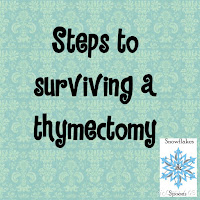Steps to surviving a Thymectomy
 When diagnosed with Myasthenia Gravis, your neurologist will start to search for the best treatment for you. One of the more drastic treatment approaches you may be faced with is a thymectomy.
When diagnosed with Myasthenia Gravis, your neurologist will start to search for the best treatment for you. One of the more drastic treatment approaches you may be faced with is a thymectomy.
I underwent my transsternal thymectomy in 2009, two years after being officially diagnosed. Here are some tips to better prepare you and your family for this operation. Please note this is from personal experience and should not be taken as medical advice. Make sure to listen to your doctors and disclose all information needed prior to this operation.
Pre-operation
- Buy pj's that button in the front for when you come out of ICU.
- Make sure you have some socks packed in for ICU as it can be chilly.
- Wash your hair. You won't be able to do this until stable and that will be with assistance.
- Neaten up below. They will be inserting a catheter and may have to shave the area to stick the tubes down.
- Try some deep breathing or meditation to help relax.
- See your assigned hospital Physiotherapist before you go in. She will make sure your chest is clear and check your breathing.
- Precook meals or delegate meal preparation to a family member for at least two weeks post op.
- Organise someone to help clean your home especially heavy work like moving furniture
- Expect to be out of service for a few days. Let important people know who to contact
Post operation
- When you wake up, it may feel overwhelming. You may still have some anaesthetics running through your veins and may not be able to move much. This will improve.
- You may have a central line, drip, breathing tube and chest tubes. These are aiding your recovery and preventing further side effects so don't fight them.
- The breathing tube will prevent you from talking. A hand squeezing or eye blinking will be your communication until it is removed.
- Make sure you are receiving enough pain medication at this stage. Morphine made me hallucinate Harry Potter came to visit, but I can't recall any pain in ICU.
- The chest tubes will come out as soon as the Doctor can determine your lungs are clear and in working order. They can be very uncomfortable especially when you move.
- Work with the Physiotherapist. They had me walking on day 2! It was crazy with two chest tubes, a drip and Frankenstein's chest, but it helps your lungs function better and to stretch those muscles that can start causing pain. It's not fun and the chest Physio felt like a jackhammer, but it helped.
- Make sure you have something with you that you enjoy doing, but takes little to no energy. Music is a good suggestion or paging through magazines. Reading may be difficult due to all the pain medication.
Recovery
 |
| No scar visible! |
- Rest as advised! No lifting, pushing or pulling of objects! Ask for help and accept it.
- Make sure you have a check up with your surgeon and neurologist once you are discharged.
- Have a rolled up towel / small pillow or stuffed animal to hold over your chest when you cough, sneeze or hiccup. This helps with pain management and prevents you from opening the wounds.
- Sleep may be uncomfortable in the beginning. Have some extra pillows to support your sore body. Some people prefer sleeping in a lazy boy chair in the beginning.
- Once your stitches come out and the wound has closed, you can start rubbing Vit E oil over the scar to prevent keloids (bumps) and extreme scarring. There will be some scarring. Silver oxide tape also can help with this process.
- Schedule social visits between rest times, don't let your visitors tire you out. Warn visitors not to hug you until you’re ready.
- Take your pain meds before you need them. I.e. If they say every 4 hours don't take them only when pain sets in at 5h. Prevention is better than cure.
- After one week at home, start bringing routine back into your day. Get dressed and do one thing you enjoy in the morning. Puzzle building, reading, watching series, scrapbooking etc then rest and try one more thing in the afternoon.
- Take this time to recharge and heal. You are not being selfish, but responsible for your Health!
Do you have any other helpful tips? Let me know and I'll be glad to add them!




If you are female, find a well fitting bra and put it on as soon as possible after the surgery. That will hold your breasts together and will keep the skin from pulling and making a big scar. My surgeon told me this, he had been a cardiac surgeon for ten years prior to switching to general thorasic. He was right, I have a very fine line down the center of my chest.
ReplyDeleteI was diagnosed with Parkinson’s disease four years ago. After relying on medications with little relief, I turned to NaturePath Herbal Clinic out of hope. Within months, I noticed real improvements tremors subsided, balance improved, and my energy returned. It’s truly been life-changing.
ReplyDeleteIf you or a loved one is facing Parkinson’s, I highly recommend exploring their natural approach.Visit: www.naturepathherbalclinic.com | Email: info@naturepathherbalclinic.com